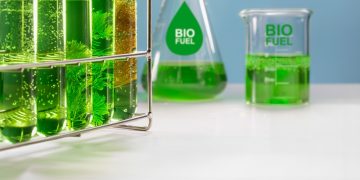
The shale gas revolution continued in 2013 with monthly natural gas production in the lower 48 states reaching 74.5 Bcf/d in July, the highest level of marketed production since 1973. Similarly, domestic oil production grew by 1.0 million barrels per day in 2013, the largest annual increase in history.
This growth in domestic crude production, to 7.44 million barrels per day, was driven primarily by tight oil production growth in the Bakken and Eagle Ford shales. As a result, prices for both natural gas and petroleum products in the U.S. remained fairly stable, as shown in Exhibit 1.

Exhibit 1: Recent Natural Gas and Diesel Prices
(Image Credit: U.S. Energy Information Administration)
As Exhibit 1 illustrates, the price spread between natural gas and wholesale diesel of approximately $18/MMBtu remained fairly constant throughout 2013.
At the same time, the pace of LNG export license approval by the Department of Energy (DOE) accelerated with five new LNG projects receiving approval to export LNG to Non-Free Trade Agreement countries. But what has happened on the domestic, small-scale LNG front?
Small-Scale LNG Market Development Status Overview
At this time last year, the wealth of positive press highlighting new liquefaction plants, truck fleets, and marine vessels indicated continuing strong expectations. Numerous studies from notable groups suggested a strong, realisable value proposition. However, since that time, some in the press have become more cautionary, industry notables such as Shell and Blu LNG have slowed their development or tabled plans, and adoption remains in the single digits.
Development activity remains high and there is plenty of capital available for projects, but the process of bringing SSLNG projects to market is taking longer than expected. Exhibit 2 characterises the current status of small-scale liquefaction facility development and suggests there is almost 5,500 kgpd of liquefaction capacity in development across the country, of which less than three percent is in construction.

Exhibit 2: Small-Mid Scale Liquefaction Facility Development Activity
The good news, as Exhibit 2 illustrates, is the robust liquefaction project pipeline, the total of which exceeds the installed capacity of the current fleet of small scale liquefaction facilities. This pipeline clearly reflects the continued belief in the natural gas fuel value proposition. Established players like Stabilis Energy, Clean Energy, Applied Natural Gas, and Noble Energy continue to pursue liquefaction projects along with new entrants like Westpac and Waller Marine.
However, the reality is that LNG fuel adoption has been slower than hoped in part because of the commercial differences between how consumers historically purchased fuel and the needs of project-financed infrastructure. Project developers initially sought 15-year supply contracts with take-or-pay provisions to support project financing, while end users historically purchased fuel on a spot-basis or under contracts with terms rarely longer than one year. However, suppliers are adapting by leveraging LNG supply from peak shavers and other existing sources to build a customer portfolio large enough to support development of a new liquefaction capacity. At the same time, investors willing to bear market risks are actively considering funding liquefaction projects entirely with equity, for a time, while demand builds to levels sufficient for traditional bank financing. This more incremental, organic business development approach has contributed to the slow pace of SSLNG project development.
Marine Segment
After years of decline in the U.S. Jones Act fleet, newbuilds are once again on the rise. The fleet, nearly 200 vessels strong in 2000, is now less than half that size. Yet a combination of vessel age, pending emission regulations, and new market demand are forcing changes – and widening natural gas fuel oil price spreads are convincing operators that LNG might be the answer.
The average age of the Jones Act fleet is 22 years, with many vessels well beyond the typical operating life of most ocean-going vessels. Replacement decisions, always complex, are made more so by sulfur dioxide limits taking effect next January and nitrous oxide limits taking effect soon thereafter, challenging the selection of fuels and emissions abatement technologies. Further, while regulatory limits are clear, enforcement is not. Though some speculate that regulatory enforcement will be intermittent at best and penalties insufficient to drive behavior, last August California levied fines against several operators and more recently the EPA and U.S. Coast Guard started finalizing ECA enforcement guidelines. While vessel age drives replacement decisions for some vessel types, others are seeing increased market demand.

Exhibit 3: U.S. Jones Act LNG Ready Vessel Announcements
Image Credit: Pace Global
As a result of aging assets and new demand, 42 LNG ready vessels are under development or construction for North America with 23 planned to Jones Act trade, 13 ferries, and 6 offshore supply boats. Of the Jones Act vessels, the bulk of ship newbuilds are for containerized, roll-on roll-off (Ro-Ro), or petroleum cargo. Given the Jones Act fleet age, it’s not surprising new builds feature prominently, and more replacements can be expected, some of which will be LNG ready.
To meet growing LNG fuel demand, suppliers are stepping up on the East, West, and Gulf Coasts. In the East, Jacksonville Florida is emerging as a first mover with TOTE signing an LNG fuel supply deal with Wespac Midstream. This interest spawned several other announcements from big-name industry participants like Clean Energy and Sempra interested in serving the Jacksonville market.
Along the West Coast, the first LNG cargo was delivered to Hawaii. For some time, high petroleum fuel prices and tightening emissions regulations drove interest in LNG from the local utilities and the Governor. For the moment, LNG importation remains at a standstill as utilities determine how best to deliver LNG, though numerous large and small players vie for this prize. Hawaiian LNG will provide the Marine community another cargo to carry and LNG fuel on both ends of a journey. Further, Hawaiian LNG will likely be supplied from the mainland U.S., requiring deliveries by Jones Act carriers. As there are no Jones Act LNG carriers, this poses both a challenge and an opportunity.
Along the Gulf Coast, Harvey Gulf launched its first of six planned duel-fueled offshore supply vessels. While Shell retreated from its planned Geismer Louisiana liquefaction plant, other local liquefaction projects continue development, most notably the large export facilities, most of which will have excess LNG fuel available to local markets. Large liquid gas markets and extensive infrastructure along the Gulf Coast allow suppliers to deliver at attractive prices. Thus quiet development continues on several smaller liquefaction facilities and LNG fueled vessels.
What does this mean to the mPace Global discusses the unprecedented development of liquefied natural gas in the U.S. and how the last 12 months have brought the fuel to the fore in the shipping industryarine community? The underlying fundamentals driving the value proposition remain strong and are beginning to overcome the vessel owner’s challenges. In the short run, owners will request EPA waivers and switch to distillate, technology permitting. However, judging by previous efforts, those waivers will require clear plans and timelines for meeting the regulations, and some will choose see LNG.
First to convert in the U.S. will be the Jones Act fleet. While tightening emissions limits provide the spark to consider LNG fuel, the need to replace aged vessels coupled with the competitive advantage LNG provides and the risk of further tightening regulations will drive fuel switching. Operators serving dedicated routes on contract will convert first, since their business models provide predictability and operating time to accrue savings to offset incremental capital. Further, U.S. port operators may follow key European ports like Rotterdam in offering fee reductions for LNG fueled vessels.
Inland vessels convert next. The same emissions and fuel prices interest tug operators, but lower vessel utilization, fewer contracted cargos, and available space will slow adoption. However, as vessels age and replacements are considered, inland vessel operators will consider competitiveness and fuel options. Larger operators will develop new LNG ready designs, perhaps taking advantage of new midstream refueling regulations. If Europe is a guide, the first new design LNG only powered harbor tug is in operation.
In our view, over the next few years LNG will provide a significant portion of U.S. marine fuel demand. Vessels will convert when economically advantaged, and will become anchor tenants for liquefaction plants and supply chains. Few owners recognise the strategic role they play in an LNG fuel project as an anchor tenant, and the value their fuel contract and credibility can bring a supplier. Without this understanding, some announced their intentions before negotiating fuel contract, thus eroding their bargaining position. This strong position will provide investment opportunities in the LNG fuel supply chain offering other revenue sources.
This whitepaper was written by Todd Thurlow, Vice President, Pace Global, A Siemens Business
In the origin, I was explicit with you propecia before and after has changed my being. It has become much more fun, and now I have to run. Just as it is incredible to sit.





























































